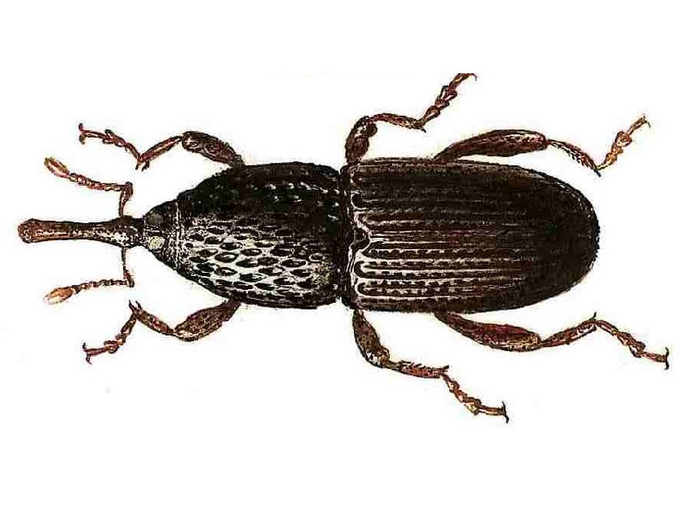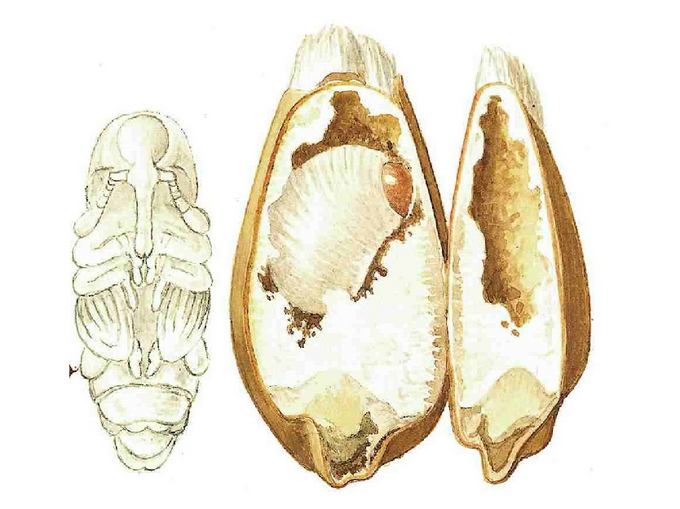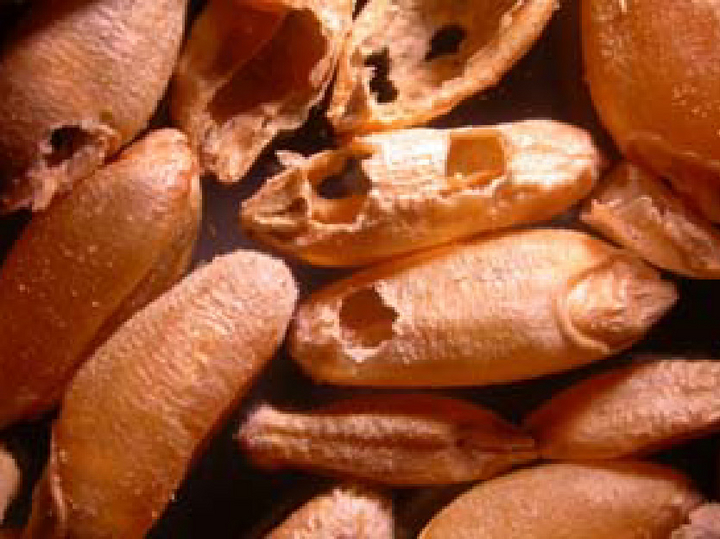Grain weevil
Sitophilus granarius
Appearance
The cylindrical beetles, measuring about 3.5 to 5 mm, are somewhat smaller than cereal grains. Their coloration changes from light brown to dark brown to blackish brown depending on age. The neck shield is longer than wide and bears longitudinal oval notches (punctation). On the elytra there are deepened longitudinal stripes.
The larvae are barrel-shaped, bear a light brown head capsule, are pale in color, and have no extremities.


Biology
The grain weevil belongs to the weevil family (Curculionidae), which are easily recognizable by their trunk-shaped elongated head. The grain weevil is flightless. The rather light-shy beetles mate already a few days after hatching. After a period of about four to ten days, the female begins to lay eggs. In the course of this, about 200 - 300 whitish shiny, 0.6 to 0.8 mm large eggs are laid in rates of up to three eggs per day. To do this, the female gnaws a short channel into a grain kernel, lays an egg inside, and closes the opening with a plug of secretion.
The development of the grain weevil from egg to newly hatched young beetle takes place entirely in the grain. They pass through four larval stages, finally pupating in their cereal grain. Development is strongly dependent on temperature and grain moisture. At optimum development temperatures of 25 °C to 29 °C, the development period of the beetles is about 34 days. Under domestic storage conditions, two to three generations per year are possible. At temperatures of 20 °C to 30 °C, the life span of the beetles is between five and twelve months. At lower temperatures of about 10 °C to 12 °C, all life processes slow down and the beetles can live up to more than two years. At low temperatures of about 5 °C, cold torpor occurs, temperatures of -10 °C are endured for up to two weeks, temperatures below -10 °C lead to cold death after only a short time. This relative cold tolerance allows the beetles to survive in unheated storage and in sheltered places in the open. At temperatures of about 38 °C, heat rigidity occurs; temperatures of 39 °C to 40 °C lead to heat death of the beetles. Reproduction is not possible at grain moisture levels below 10%, but such low moisture levels are almost unheard of in Europe. In empty storage rooms (without food), beetles are able to stay alive for the whole winter, and in summer for one to two months.
Damage symptoms

The larvae almost completely hollow out the grain. High infestation densities therefore result in enormous weight losses, and the cereal becomes musty. The feeding activity of the beetles and larvae and the associated metabolic processes lead to an increase in temperature and moisture in the stored material. As a result, fungi and bacteria colonize, the stored goods clump together, become inedible and finally take on a manure-like odor. Due to the formation of condensation water, the stored grain begins to grow out on the surface.
Host plants
The adult beetles feed on cereals as well as cereal products, such as flour, meal and semolina. The development of their larvae, on the other hand, is only possible in whole cereal grains. Besides the various cereals, development can also take place in corn, millet, buckwheat and pasta, but not in legume seeds, pumpkin seeds, sunflower seeds, or similar.
Propagation and transmission
Grain weevils are flightless because their hind wings are regressed. The pest is introduced when grain already infested with eggs and larvae is purchased. Infestation is often not discovered until beetles or the typical holes from which the adult beetles hatch are visible in the grain. To prevent spread and transmission, the grain should be inspected regularly.
Prevention and control
General hygiene measures
- Thorough cleaning of harvesting and transport machinery
- Thorough cleaning of storage areas (removal of junk and cleaning waste) before storage
- Destruction of already infested stocks
- Sealing of windows and doors with rubber lips and insect screens
- Insulation of ceilings and walls to prevent condensation
- Plastering of gaps, cracks and porous walls, avoiding floorboards and wooden boarding with joints and gaps
- Cooling of the stored goods to 10-13 °C
- Empty space treatment with a recognized insecticide (see list of plant protection products approved in Austria) or heat treatment
Proof
- Periodic temperature measurement: a rise in temperature in the stored goods provides information about the presence of storage pests
- Sampling with a grain sampler
- Sieving of the samples with a continuous sieve
- Noise measurement: detection of larval feeding noises by inserting a sensitive microphone into the stored food.
Control
- Inert dusts (diatomaceous earth) and contact insecticides (see list of plant protection products approved in Austria) enable successful control of adult beetles and larvae if they are well distributed in the stored material (note: eggs already laid are not detected and lead to renewed infestation at temperatures above 19 °C).
- Reliable killing is achieved with gaseous preparations (phosphoric hydrogen, see list of plant protection products approved in Austria) and inert gases (nitrogen, carbon dioxide), provided that the stored goods to be treated are tightly sealed (note: specified dosages, temperatures and exposure times must be adhered to).
- Heat treatment (60 °C for three minutes) or cold treatment (below -10 °C) are possible, but only effective for smaller batches due to the high energy input.
- Biological control is achieved, among other things, by releasing the storage wasp Lariophagus distinguendus. This insect finds the grain weevil larvae and pupae that live hidden in the grain.
Tips for household use
- Store food only in tight-fitting storage containers with rubber seals or screw caps
- Dispose of all infested food directly into the trash can outside the home
- Remove bugs sitting around with a vacuum cleaner
- Fly screens on (roof) windows, doors and skylights reduce the risk of infestation
- If you find yourself repeatedly struggling with grain weevils, heirloom wasps can help. These are natural enemies of the beetles and are simply released in the kitchen(Lariophagus distinguendus, see list of plant protection products approved in Austria).
Last updated: 03.10.2025
automatically translated